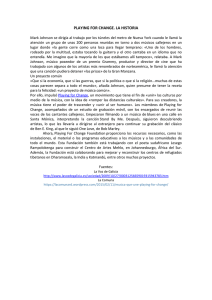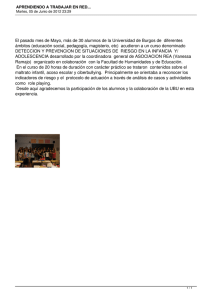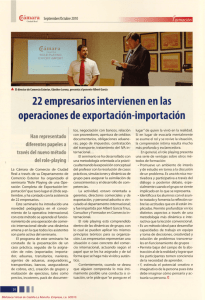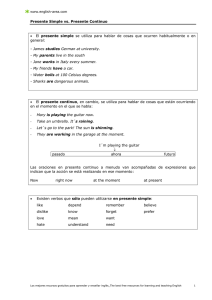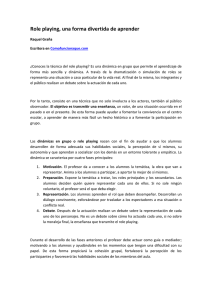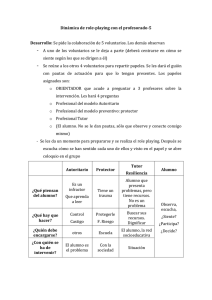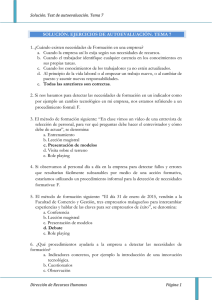Document
Anuncio
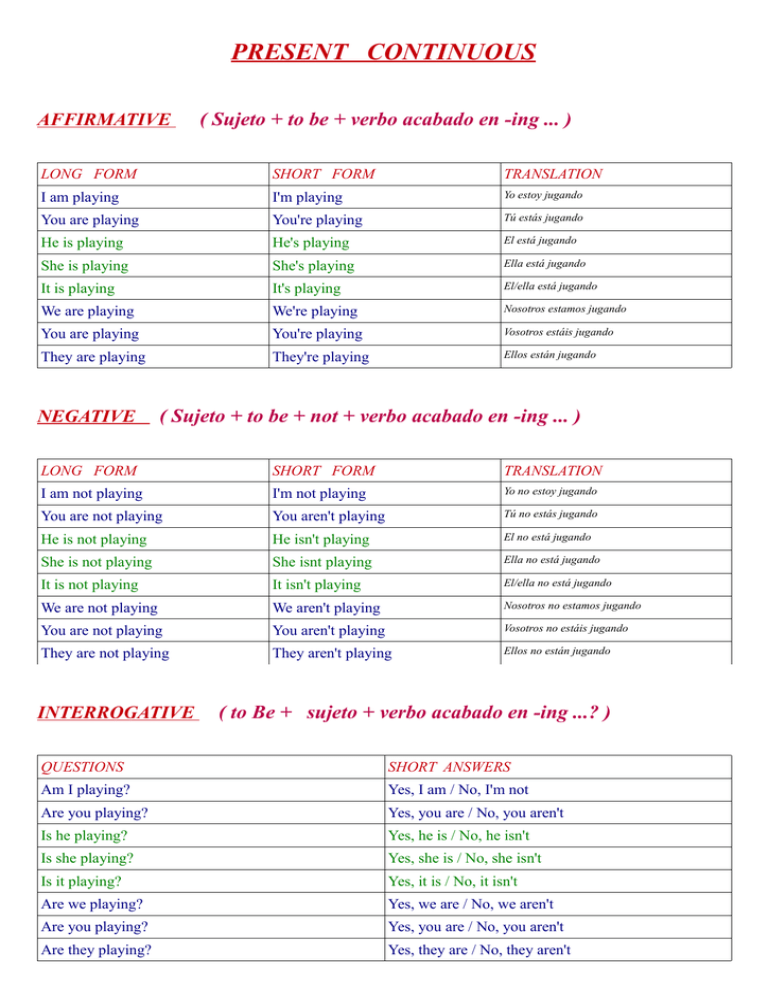
PRESENT CONTINUOUS AFFIRMATIVE ( Sujeto + to be + verbo acabado en -ing ... ) LONG FORM SHORT FORM TRANSLATION I am playing I'm playing Yo estoy jugando You are playing You're playing Tú estás jugando He is playing He's playing El está jugando She is playing She's playing Ella está jugando It is playing It's playing El/ella está jugando We are playing We're playing Nosotros estamos jugando You are playing You're playing Vosotros estáis jugando They are playing They're playing Ellos están jugando NEGATIVE ( Sujeto + to be + not + verbo acabado en -ing ... ) LONG FORM SHORT FORM TRANSLATION I am not playing I'm not playing Yo no estoy jugando You are not playing You aren't playing Tú no estás jugando He is not playing He isn't playing El no está jugando She is not playing She isnt playing Ella no está jugando It is not playing It isn't playing El/ella no está jugando We are not playing We aren't playing Nosotros no estamos jugando You are not playing You aren't playing Vosotros no estáis jugando They are not playing They aren't playing Ellos no están jugando INTERROGATIVE ( to Be + sujeto + verbo acabado en -ing ...? ) QUESTIONS SHORT ANSWERS Am I playing? Yes, I am / No, I'm not Are you playing? Yes, you are / No, you aren't Is he playing? Yes, he is / No, he isn't Is she playing? Yes, she is / No, she isn't Is it playing? Yes, it is / No, it isn't Are we playing? Yes, we are / No, we aren't Are you playing? Yes, you are / No, you aren't Are they playing? Yes, they are / No, they aren't USOS: El presente continuo se usa para: >>Expresar acciones o hechos que ocurren en el mismo momento de hablar o en un contexto muy cercano a éste. It is raining now. > Ahora está lloviendo. I'm playing a football match. > Estoy jugando un partido de fútbol. >>Expresar acciones en curso aunque no se estén realizando necesariamente en el momento de hablar. This year, I am learning French. > Este año estoy aprendiendo francés. >>En otras ocasiones es utilizado con sentido de futuro para indicar, principalmente, planes inmediatos que se van a realizar con total seguridad. I am playing tennis with Ann tomorrow. > Mañana juego al tenis con Ann. Las frases con presente continuo suelen acompañarse de expresiones como: LOOK ! (¡mira!) / NOW (ahora) / TODAY (hoy) / AT THE MOMENT (en este momento) -ING : Formas irregulares >>Los verbos acabados en una vocal y una consonante duplican la consonante final sit / sitting // swim / swimming >> Los verbos acabados en –e pierden la e: dance / dancing // write / writing LOS SIGUIENTES VERBOS CASI NUNCA SE EMPLEAN EN PRESENTE CONTINUO: Verbos que expresan sensaciones, como feel (sentir), hear (oír), see (ver) o smell (oler). Verbos que expresan posesión, como belong (pertenecer), own (ser propietario de) o possess (poseer). Verbos que expresan sentimientos o emociones, como desire (anhelar), detest (detestar), dislike (disgustar), fear (temer), hate (odiar), like (gustar), love (amar), respect (respetar), want (querer) o wish (desear). Verbos que expresan actividades mentales, como agree (estar de acuerdo), believe(creer), forget (olvidar), know (saber), realize (darse cuenta), recognize (reconocer),remember (recordar), suppose (suponer), think (pensar) o understand (entender).
